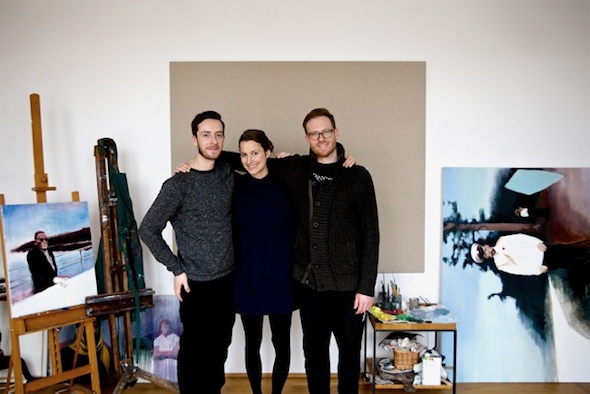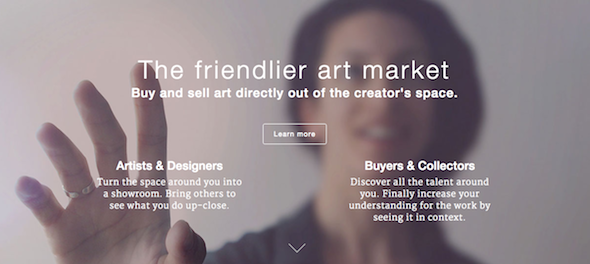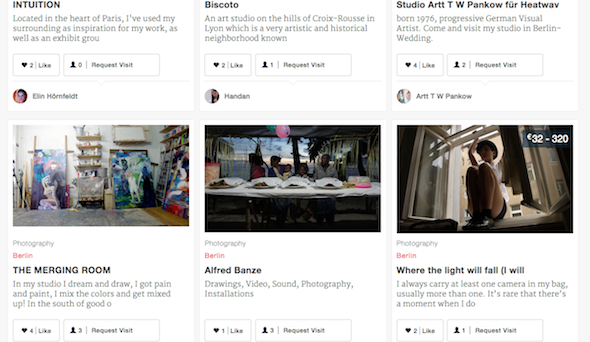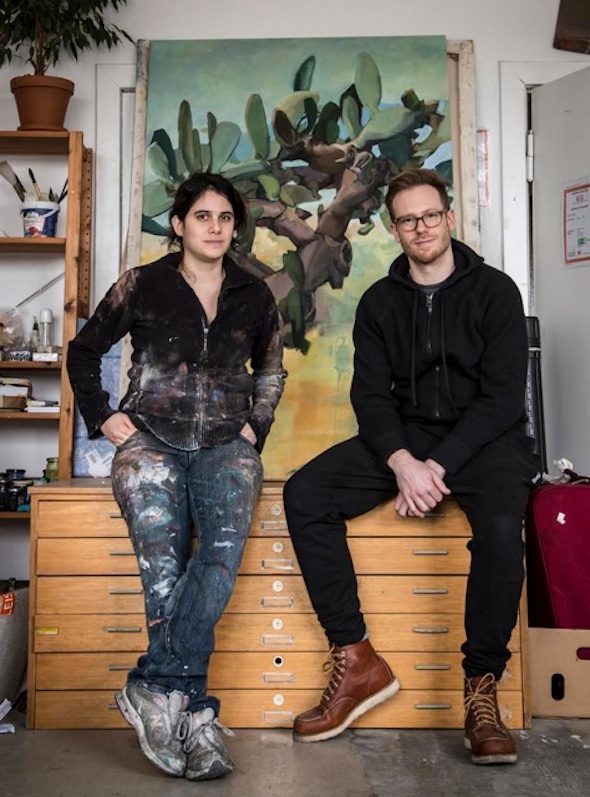Interview by Alison Hugill in Berlin; Monday, Mar. 09, 2015
As the tagline goes, Verni.us is a site that actively tries to build a “friendlier” and more accessible art market. Using a social media platform resembling Air BnB, the founder Robin Greenwood aims to connect artists directly with buyers, by arranging studio visits. The site bypasses art institutions and their inherent inequalities by taking matters into the artist or buyer’s own hands. Visitors to the platform can create profiles and arrange meetings online. Berlin Art Link spoke to Greenwood about the impetus behind creating the site.
 Artists Stephi Scholz www.verni.us/Scholz/galleries/145 and Fred Mann www.verni.us/mann/galleries/192 with Verni Founder Robin Greenwood
Artists Stephi Scholz www.verni.us/Scholz/galleries/145 and Fred Mann www.verni.us/mann/galleries/192 with Verni Founder Robin Greenwood
Alison Hugill: Can you tell us about how verni.us works and how you envision the ideal connection between artist and audience through your site?
Robin Greenwood: I envision Verni as the easiest way to connect with the talent around you. Verni creates a friendly and trustworthy environment online for users to discover and actually meet their artistic community offline.
It starts with artists creating an open studio profile. This includes photos, descriptions, categories and a location. These studio profiles are displayed on a map, as well as on a feed, where users can filter by distance, popularity or category. If interested, users can ask to visit these studios with a simple click of a button. Artists are notified by email and on the site, and can view the visitor’s profile to decide if they’d like to welcome them in. A user’s profile includes recent activity, bio, website, and social connections. Users can also message each other directly through the site if more information is needed. When accepted, visitors receive additional contact information from the artists in order to conduct a visit.
AH: Is the platform open to anyone who wants to show their work, or is there a preference for emerging and ‘hidden’ artistic talent, unrepresented by galleries?
RG: Verni builds connections based on the artistic work and geo-location more than on resumes. If you are an artist creating work that you want others to see up close, and you feel that a more personal connection and dialog about your work will increase the appreciation for it, then Verni is for you. The site enables all artists, irrespective of their career stage, to connect independently with their community. For some, it may be a helpful stepping stone prior to achieving gallery representation, while for others it’s an additional way to develop an audience naturally.
AH: The website provides an opportunity for people to visit the artists’ studios. If I liked someone’s work I could, for example, visit their studio in Berlin and meet them in person. Despite being a decidedly web-based social network – this site has implications in the real world. Have their been any specific shining success stories you’ve heard about?
RG: Yes. We’re very excited to hear that artists are already selling their work via Verni. The metric that’s most interesting to me is the number of visits that are taking place. I can proudly say that this number is growing steadily, and that artists have already found ways to take advantage of Verni as a location-based social network. Artists are meeting other artists and rediscovering their creative neighborhoods.


AH: Verni.us is like a cross between Tinder and Air BnB for artists – with functions to discover artists in your area and within your price range. There is already a proliferation of online galleries hosting and selling exclusively online content. Do you see the potential for the art market to move online entirely in the near future?
RG: I think it’s important to understand how we can use the web to empower us offline. I’m a big fan of the Sharing Economy, because it encourages us to utilize our existing space, connect with other like-minded people, and take part in a collective experience. Verni models very much the same behavior just for art. You could say that Verni provides an alternative to a strictly online art market experience.
I believe an entirely online experience is boring and unsustainable. Works of art are one of a kind, and unlike music, essential parts of the experience are lost when viewing them online only. So why should we treat them the same? Many online art platforms constrain their user experience to swiping pages in catalogue after catalogue of work, reading descriptions, and professional reviews about the work without ever getting close to it. Reading about an experience is nothing like experiencing it yourself. We all know that.
Established artists have values associated with their names that most of us recognize. However, for emerging artists it’s a different ball game. For us to gain the same amount of confidence to buy works from emerging talent it’s important we connect on a personal level. Simply seeing the work in context can be the deciding factor when it comes to buying the work.
For me, art has the potential to surprise and to bring new ideas and concepts to my attention. I wouldn’t want to limit this moment to something on my couch. It’s really empowering to experience art in the environment in which it was created or intended to be seen. I’ve been fortunate to have that experience now more often, and I wish the same for others.
AH: The early utopian promise of the internet has largely led to privatization by a few major corporate players. Is there a political reasoning behind your decision to create this site: are you trying to allow common access to the kind of privileged viewing that most artists struggle to get?
RG: Yes, exactly. Verni’s goal is to expand the art market’s audience. If art is a part of our culture, then I believe everyone should have a chance to participate in it. The talent is there, and people are hungry to discover it. Verni simply wants to make it easier for the two to connect.
Currently, the art world consists of many self-serving middlemen. At the top is a small group of collectors that rule the market. Many galleries and curators feel pressured to cater to this group. By doing so, works of art that don’t fit that requirement, or artists whose names don’t ring a bell have a more difficult time to get exposure. As a society we’ve accepted this, and indirectly teach it in our schools. By saying that an artist’s life is full of risks, we don’t do enough to challenge this model. We end up disenfranchising ourselves from the art world.
However, there’s really good news. This is an old pre-Internet model, just waiting to be disrupted. Millions of artists, and millions of people in the public can now connect and participate in this market collectively. Imagine what will happen when all the artists that have previously been underrepresented (women 30% gallery representation, minorities 15% gallery representation) now have a chance to tell their story. I believe that once we’ve built a trusted network to connect people efficiently to their surrounding talent, that this archaic system will no longer dominate. When this happens, becoming an artist will have less and less to do with taking risks and more to do with contributing even more meaningfully to our culture.
 Liat Grayver and Robin Greenwood
Liat Grayver and Robin Greenwood
Verni profile: www.verni.us/LiatGrayver/galleries/141
___________________________________________________________________________________
Additional Information
Find out more about Verni.us here: www.verni.us
Instagram: www.instagram.com/getverni
Twitter: www.twitter.com/getverni
___________________________________________________________________________________
Interview by Alison Hugill in Berlin; Monday, Mar. 09, 2015.



















